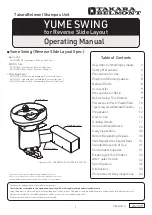
APOLLO LOW PRESSURE SUPPLIED-AIR RESPIRATOR
Page 11
HELMET MODEL 20
© 2011 CLEMCO INDUSTRIES CORP.
www.clemcoindustries.com
Manual No. 21991
8.2.1.2
Wash the suspension pads, suspension web,
and chin strap with warm water and mild detergent, and
rinse with clean, warm water.
8.2.1.3
Squeeze pads to remove excess water. Wrap
pads in a towel and squeeze to remove additional water.
All items may be air-dried or tumble-dried at the lowest
possible setting.
8.2.2
Web Suspension with Sweatband (alternate)
8.2.2.1
Refer to Section 9.6.2 to remove and replace the
suspension. Wash the sweatband, suspension, and chin
strap, using warm water and mild detergent, and rinse
with clean water. Remove excess water with a towel and
allow to air-dry.
8.3 Helmet
Assembly
8.3.1
The helmet assembly should be wiped clean
with a cloth dampened with water and mild detergent. If
the helmet must be immersed in water, remove the
breathing tube, cape, suspension and all other
removable items before immersing. While this will not
permanently damage the helmet, it will require an
extended drying period.
8.3.2
Care must be taken to prevent abrasive entry
when donning and removing the respirator and when
changing lenses. Vacuum the inside of the helmet to
remove any abrasive.
8.4 Disinfecting
8.4.1
Washing the respirator as instructed also
disinfects it. Additional disinfecting may be done before
and/or after use by wiping the surfaces with a
commercial disinfecting wipe or spray.
9.0 SERVICE
MAINTENANCE
CAUTION
To prevent recontamination of the respirator,
clean the respirator of dust and abrasive before
maintenance. All maintenance must be done in
a clean environment away from dust and
abrasive, and outside the respirator use area.
9.1
Replacing Outer and Middle Lenses
Preparing lenses in the following manner will permit the
cover lenses to be torn off while blasting to expose a
fresh lens as needed, while preserving the innermost
perforated lens to protect the middle lens.
9.1.1
Unlatch and open the lens frame, and remove
remnants of old lenses. The middle lens may be reused
if it is in good condition.
9.1.2
Inspect the lens frame gasket; replace if worn or
damaged.
9.1.3
Inspect the window gasket and inner lens. If
necessary replace per Section 9.2.
9.1.4
Up to three cover lenses may be installed at one
time. For maximum visibility, install only enough lenses
to last during a work period.
9.1.5
Preparing lenses in the following manner will
permit lenses to be pulled off easily by a user wearing
heavy gloves.
9.1.6
Place the middle lens on a clean flat surface.
Place up to three cover lenses on top of it.
9.1.7
Fold the pull-tab of the bottom lens down as
shown in Figure 4.
9.1.8
Fold the pull-tab of the center, and top lens up.
Figure
4
Fold the pull-tab of the
top and center lens
"
up
"
Fold the pull-tab of the
bottom lens
"down"
Middle Lens
Perforated cover lens





































